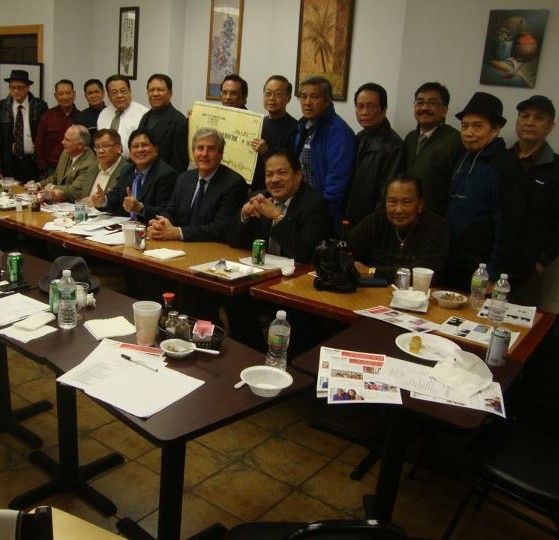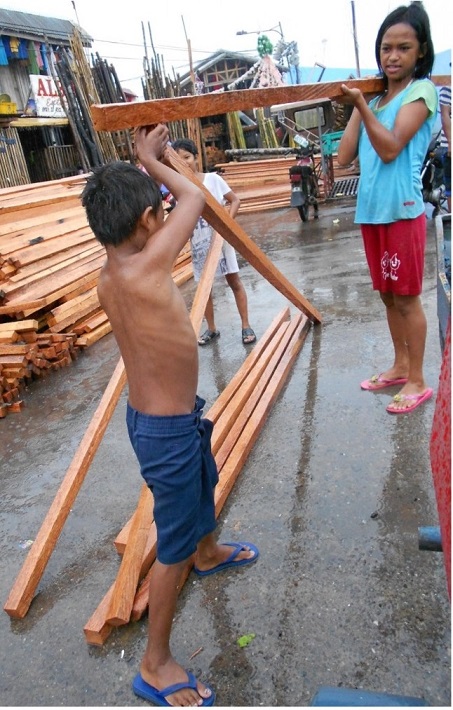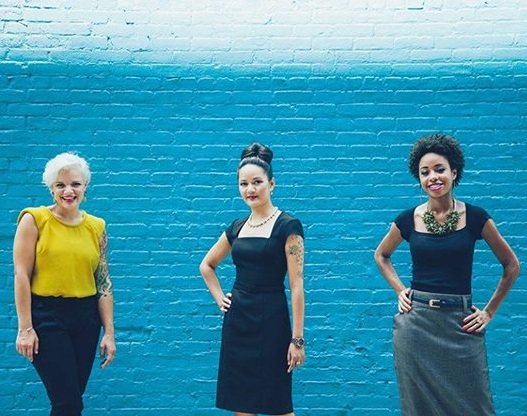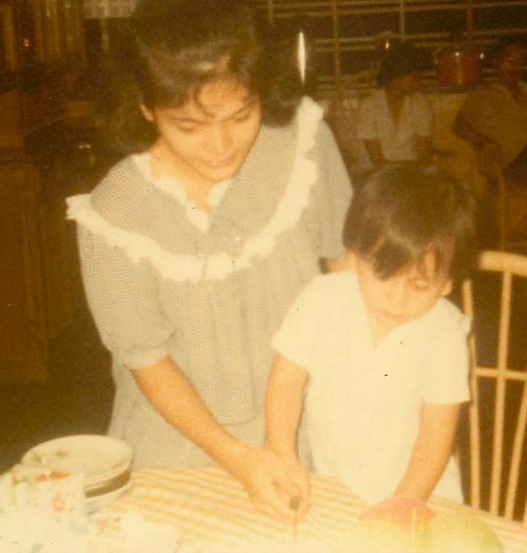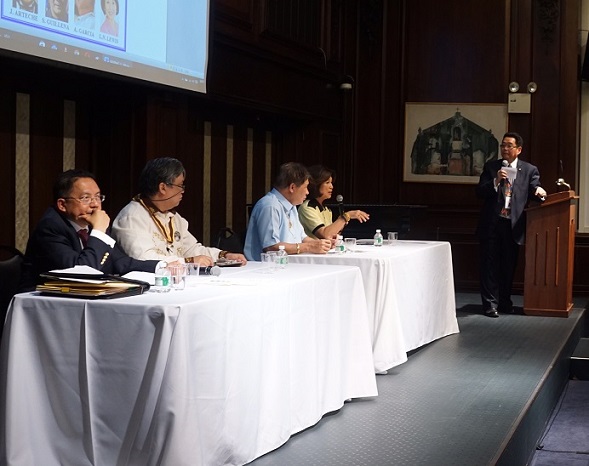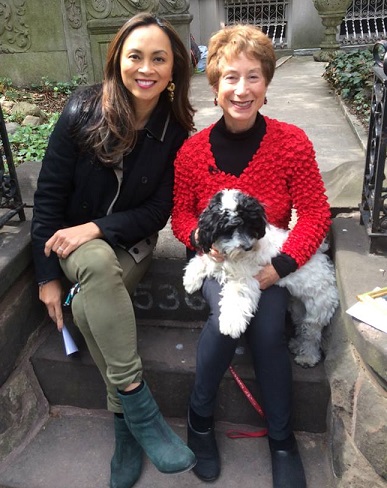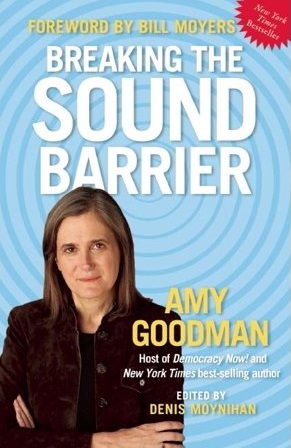Risa Puno’s art installation celebrates the Halo-Halo
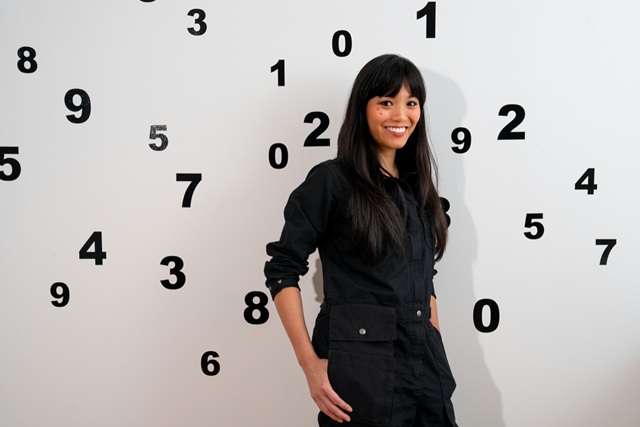
By Claire Mercado-Obias
Summer in New York City means time outdoors. If you are in lower Manhattan’s Brookfield Place, step out to the Waterfront Terrace and head to the colorful picnic tables. Perhaps the colors will remind you of manatamis na saba, kaong, gulaman, leche flan, and ube, thekey ingredients of Halo-Halo (mix-mix), the shaved ice dessert from the Philippines.
This outdoor installation, titled Common Picnic: Halo-Halo Edition, is the work of Filipina American artist Risa Puno.
“I’m an interactive installation artist who takes play seriously. I make a lot of public art, usually designed to be touched,” Risa describes. “It’s a series of wooden picnic tables and benches that are all interconnected so that people end up sharing space with others. Situated under a canopy for shade, they are painted bright colors, inspired by Halo-Halo. It’s the perfect spot to gather with friends, read a book, or admire the view of the Hudson River.”
As the recipient of the 2025 Brookfield Place New York Annual Arts Commission, Risa was provided with many opportunities to create art in a public setting.
According to Courtney Whitelocke, vice president of Brookfield Properties Arts & Events, “We have presented Risa’s work previously and have always admired how her installations are playful, accessible, and encourage interactivity. Her work is often layered with deeper meanings. With Common Picnic: Halo-Halo, she takes something familiar, a picnic table, and uses it to explore memory, identity, connection, and culture. That balance of joy and depth is exactly what we love to share through our public art programming.”
“Public art brings people together and encourages reflection and dialogue. The beauty of public art is that it’s free, accessible, and part of daily life. We believe in bringing our public spaces to life through world-class art.”
“At Brookfield Place, art is everywhere and all that is needed is an open mind. Our collection ranges from temporary installations to permanent works. Each piece tells a story, inviting you to pause, reflect and enjoy. We always encourage reading any accompanying signage for context and artist’s notes, as it can add insight, but your personal interpretation is just as important. Our goal is to present art that’s inviting and engaging to everyone,” Courtney continues.
Risa was born in the United States, lived briefly in the Philippines, and the family moved to Louisville, Kentucky where her parents practiced medicine.

“My original career goal was to be an orthopedic spine surgeon like my dad. I originally started at Brown University in the eight-year Liberal Medical Education Program. I even authored research papers that were published in medical journals and my summer job was harvesting spines from fresh cadavers. But pre-med isn’t a major at Brown so they encouraged us to be well-rounded. I never got to take Art in high school, so I decided to become a Visual Arts major. And of course, I fell in love with it and had to have an awkward conversation with Dr. Mom and Dr. Dad,” recounts Risa.
“I applied to MFA programs because I assumed that people went to school to learn how to do something. I moved to New York after getting into New York University and I’ve been here ever since. I’ve had to chart my own course—I knew of painters who showed with commercial galleries, but I didn’t know anything about how to pursue a career making public art or immersive installations. For the last 20+ years, I’ve been defining what an “interactive installation artist” is for myself, which sometimes feels like doing a ton of proposals for exhibitions, grants, and commissions! But it’s incredibly rewarding. Every opportunity to share my work and connect with people feels like a true gift.”
Risa started out taking painting classes and progressed to sculpture.
“There is something about creating dimensional things that appeals to me,” she said. “I transitioned into making installation art because I wanted to make work that is not on a pedestal and fully surrounds you. I started making interactive installations for people to be able to touch the work and have agency over their own experience. The transition into making work for the public realm was a natural one because I love how public art becomes a part of people’s everyday lives.”
“There weren’t artists in my family, so I’ve always wanted to make work that was approachable to the average person. That’s why I often use familiar objects or games—because they create an easy access point for engagement.”
While she has lived in the U.S. for most of her life, her heritage is part of her art.
“Growing up in Kentucky in the 80s, I didn’t feel a strong influence of Filipino culture because my parents encouraged my brother and me to assimilate. We weren’t taught Tagalog and our only connections to our culture were through food, religion, and random family traditions.
“However, as an adult, I’ve found other Filipinx and FilAm creatives in NYC and reconnected with my heritage. I used to feel like I wasn’t Filipino enough or American enough, but thanks to my community, I now feel very comfortable embracing my identity exactly as I am. And I’ve learned that I carry embodied knowledge from my family and ancestors that I didn’t even realize. For example, for many years, I’d been making interconnected objects—picnic tables, cast iron pans, brownstone stoops—as well as making artwork and games about human relationships and emotions, where what you do affects other people. And I used to struggle to find words to describe how all of it fit together.”
“My friend Miguel de Leon taught me the word kapwa—meaning shared identity or shared humanity. It represents a precolonial Philippine ideology about how we navigate spaces as a community, rather than as individuals. And even though I had just learned the word, it was like I had known the concept all my life. It was the way my parents patched up kids in the neighborhood when they got hurt. Or the way we were taught to always lend a hand whenever we can. It is the moral imperative I feel to care for you the way I would myself. It’s just something I knew in my bones. And it was the word I was looking for that described the underlying concept in all my work.
“I can’t help but share my learnings with joy. At the very least, out of gratitude to my friends who helped me, I hope that I can help a few FilAms feel a little more comfortable in their skin too,” Risa concludes.
New York City is a melting pot of races and cultures, and just like Halo-Halo, it’s coming together to mix and mingle for there is room for everyone.
Common Picnic: Halo-Halo Edition
May 1 to September 1, 2025
Waterfront Plaza at Brookfield Place
230 Vesey Street, Manhattan NY 10281
Claire Mercado-Obias is a writer, food stylist, and pastry chef based in New Jersey.

